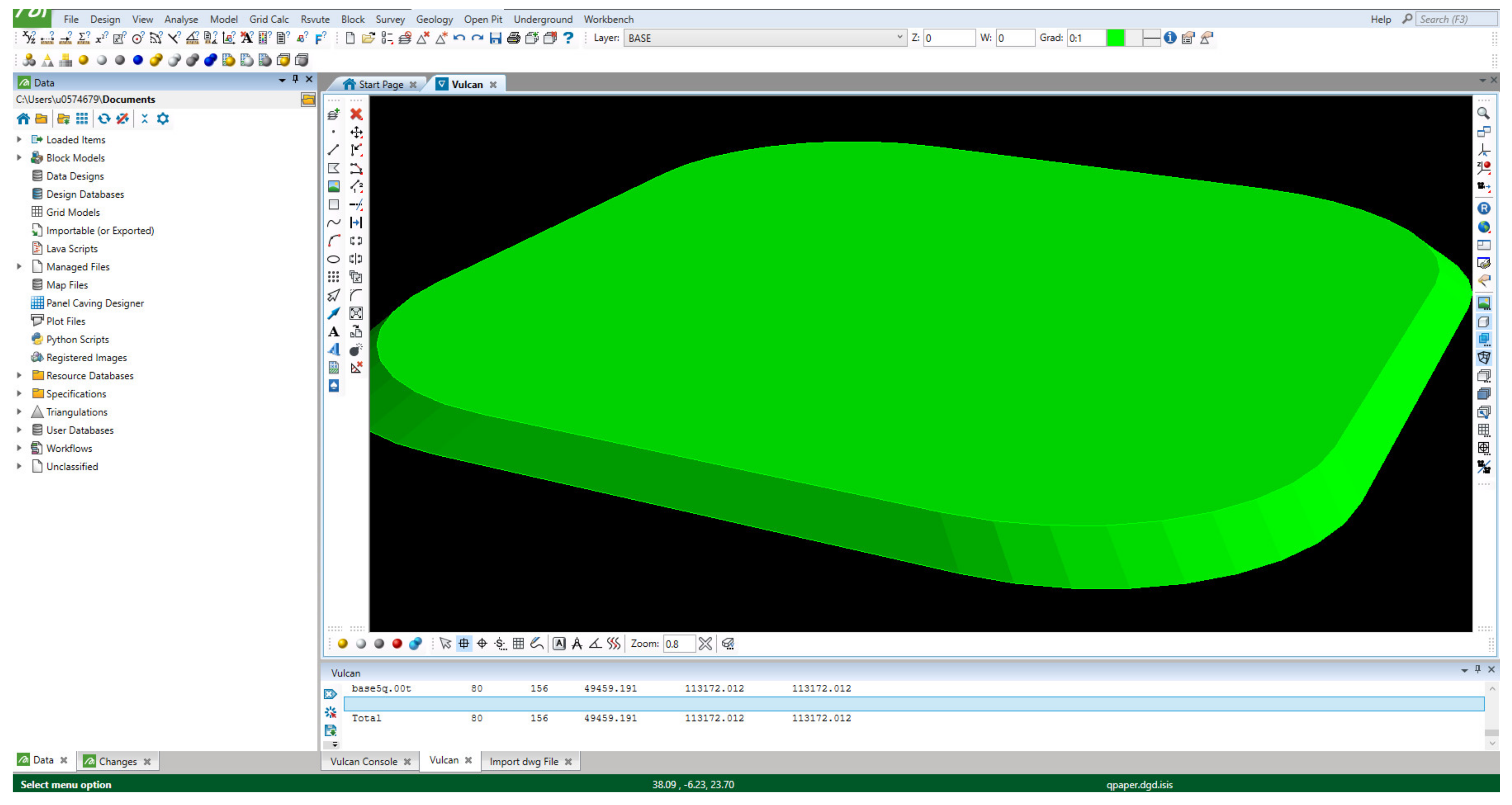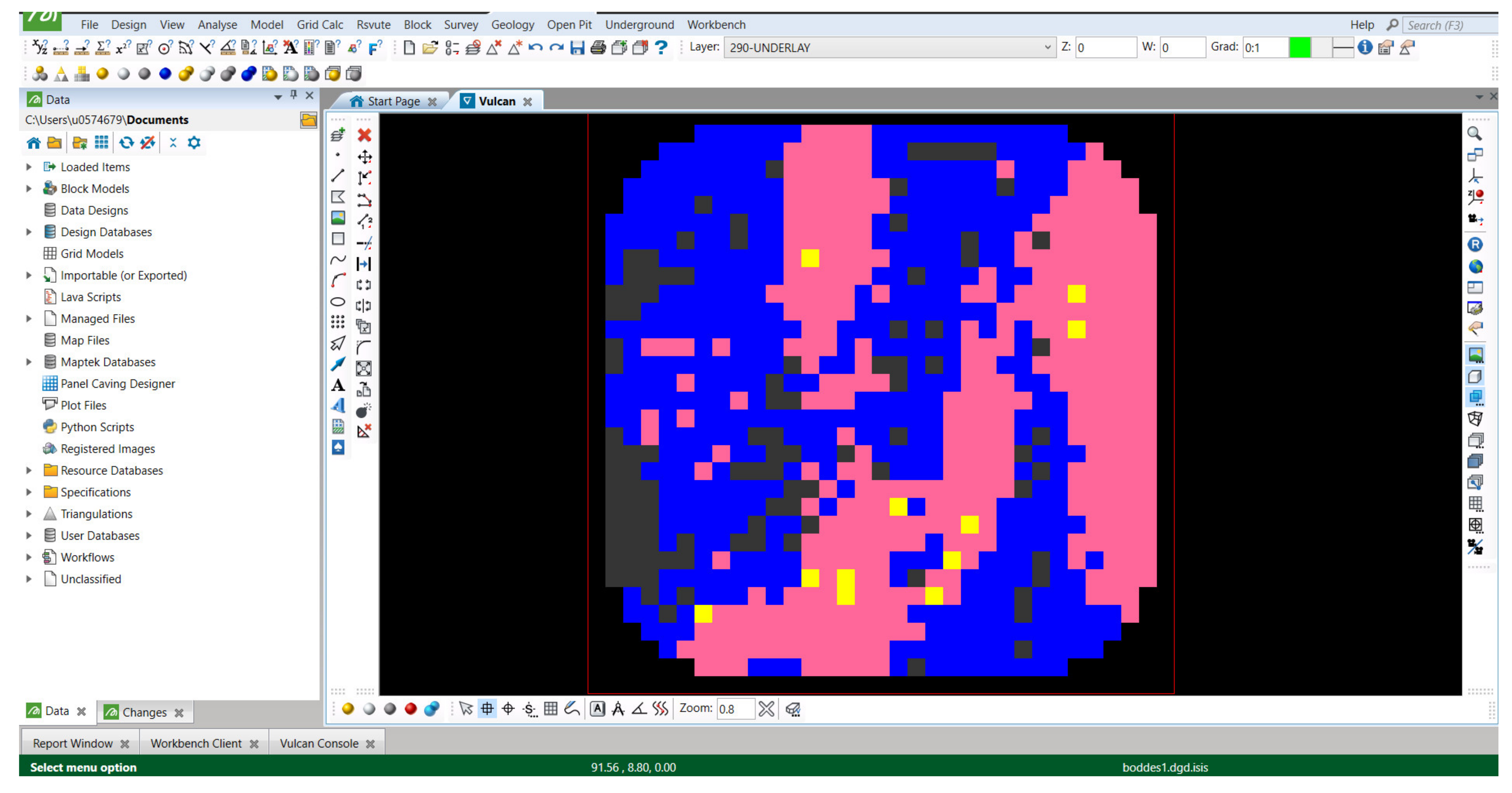Modelling Large Heaped Fill Stockpiles Using FMS Data
Abstract
:1. Introduction
1.1. Objective
1.2. Background
1.3. Classification of Stockpiles
1.4. Reconciliation and Metallurgical Accounting
- Sampling accuracy,
- Data recording and material tracking,
- Geological modelling and estimation errors,
- Short-term and intermediary stockpile accounting,
- Mine design and mine planning,
- Grade control,
- Dispatch,
- Survey inconsistencies,
- Interdepartmental communication,
- Mine operations,
- Management,
- Training and turnover of employees, and
- Dilution, natural leaching and other factors.
1.5. Reserve and Operational Models
1.6. Sampling
1.7. Current Practice and Scope
2. Materials and Methods
2.1. Approach
2.2. Data
2.3. Model
3. Results
3.1. Data Visualization
3.2. Base Layer/Paddock Dumping Model
3.3. Upper Layer/Edge Dumping Model
3.4. Interpolation Model
3.5. Analysis
4. Discussion
4.1. Workflow
4.2. Data
4.3. Modelling
4.4. Other Factors
5. Conclusions
Author Contributions
Funding
Data Availability Statement
Acknowledgments
Conflicts of Interest
References
- Hustrulid, W.A. Open Pit Mine Planning & Design, 3rd ed.; Kuchta, M., Martin, R.K., Eds.; CRC Press: Boca Raton, FL, USA; Taylor & Francis Distributor: London, UK, 2013. [Google Scholar]
- Rogers, W.P.; Kahraman, M.M.; Dessureault, S. Exploring the value of using data: A case study of continuous improve-ment through data warehousing. Int. J. Min. Reclam. Environ. 2019, 33, 286–296. [Google Scholar] [CrossRef]
- Young, A.; Rogers, P. A Review of Digital Transformation in Mining. Min. Met. Explor. 2019, 36, 683–699. [Google Scholar] [CrossRef]
- Kanefsky, J.; Robey, J. Steam Engines in 18th-Century Britain: A Quantitative Assessment. Technol. Cult. 1980, 21, 161. [Google Scholar] [CrossRef]
- Mudd, G.M. Gold mining in Australia: Linking historical trends and environmental and resource sustainability. Environ. Sci. Policy 2007, 10, 629–644. [Google Scholar] [CrossRef]
- Zhang, K.; Kleit, A.N. Mining rate optimization considering the stockpiling: A theoretical economics and real option model. Resour. Policy 2016, 47, 87–94. [Google Scholar] [CrossRef]
- Optimum Determination of Sub-Grade Stockpiles in Open Pit Mines; The Australasian Institute of Mining and Metallurgy: Carlton, Australia, 1988.
- Brennan, M.J.; Schwartz, E.S. Evaluating Natural Resource Investments. J. Bus. 1985, 58, 135. [Google Scholar] [CrossRef] [Green Version]
- Lane, K.F. The Economic Definition of Ore: Cut-Off Grades in Theory and Practice; Mining Journal Books: London, UK, 1988. [Google Scholar]
- Menabde, M. Mining Schedule Optimisation for Conditionally Simulated Orebodies. In Advances in Applied Strategic Mine Planning; Dimitrakopoulos, R., Ed.; Springer International Publishing: Cham, Switzerland, 2018; pp. 91–100. [Google Scholar]
- Asad, M.W.A. Cutoff grade optimization algorithm with stockpiling option for open pit mining operations of two economic minerals. Int. J. Surf. Min. Reclam. Environ. 2005, 19, 176–187. [Google Scholar] [CrossRef]
- Asad, M.W.A.; Dimitrakopoulos, R. Optimal production scale of open pit mining operations with uncertain metal supply and long-term stockpiles. Resour. Policy 2012, 37, 81–89. [Google Scholar] [CrossRef]
- Chanda, E.; Dagdelen, K. Optimal blending of mine production using goal programming and interactive graphics systems. Int. J. Surf. Min. Reclam. Environ. 1995, 9, 203–208. [Google Scholar] [CrossRef]
- Gu, Q.; Lu, C.; Guo, J.; Jing, S. Dynamic management system of ore blending in an open pit mine based on GIS/GPS/GPRS. Min. Sci. Technol. (China) 2010, 20, 132–137. [Google Scholar] [CrossRef]
- Jupp, K.; Howard, T.J.; Everett, J.E. Role of pre-crusher stockpiling for grade control in iron ore mining. Appl. Earth Sci. 2013, 122, 242–255. [Google Scholar] [CrossRef]
- Everett, J. Simulation Modeling of an Iron Ore Operation to Enable Informed Planning. Interdiscip. J. Inf. Knowl. Manag. 2010, 5, 101–114. [Google Scholar] [CrossRef] [Green Version]
- Everett, J.E.; Howard, T.J.; Jupp, K. Simulation modelling of grade variability for iron ore mining, crushing, stockpiling and ship loading operations. Min. Technol. 2010, 119, 22–30. [Google Scholar] [CrossRef]
- Carter, R.A. Staying on Top of Stockpile Management. Eng. Min. J. 2018, 219, 58. [Google Scholar]
- Vangold Resources Completes Acquisition of Historic El Pinguico Mine, Guanajuato, Mexico. Accesswire, Junior Mining Network. 2017. Available online: https://www.juniorminingnetwork.com/junior-miner-news/press-releases/1961-tsx-venture/gsvr/31757-vangold-resourcescompletes-acquisition-of-historic-el-pinguico-mine-guanajuato-mexico.html (accessed on 10 June 2021).
- Preece, H. Gencor is Building up Stockpile of Gold Ore, in American Metal Market. 1986. Gale General OneFile. Available online: www.gale.com/apps/doc/A4256121/ITOF?u=marriottlibrary&sid=bookmark-ITOF&xid=edcc5334 (accessed on 10 June 2021).
- Bulbeck, C. The Iron Ore Stockpile and Dispute Activity in the Pilbara. J. Ind. Relat. 1983, 25, 431–444. [Google Scholar] [CrossRef]
- Ozols, V. Anvil Range to Shutter Mine: Company Will Process Ore from Existing Stockpile, in American Metal Market. 1996. Gale General OneFile. Available online: www.gale.com/apps/doc/A18883408/ITOF?u=marriottlibrary&sid=bookmark-ITOF&xid=c27bb2d5 (accessed on 10 June 2021).
- Koushavand, B.; Askari-Nasab, H.; Deutsch, C.V. A linear programming model for long-term mine planning in the presence of grade uncertainty and a stockpile. Int. J. Min. Sci. Technol. 2014, 24, 451–459. [Google Scholar] [CrossRef]
- Zhao, S.; Lu, T.-F.; Koch, B.; Hurdsman, A. 3D stockpile modelling and quality calculation for continuous stockpile management. Int. J. Min. Process. 2015, 140, 32–42. [Google Scholar] [CrossRef]
- Zhao, S.; Lu, T.-F.; Koch, B.; Hurdsman, A. Stockpile Modelling Using Mobile Laser Scanner for Quality Grade Control in Stockpile Management. In Proceedings of the 2012 12th International Conference on Control Automation Robotics & Vision (ICARCV), Guangzhou, China, 5–7 December 2012; pp. 811–816. [Google Scholar]
- Sensogut, C.; Ozdeniz, A.H. Statistical modelling of stockpile behaviour under different atmospheric condi-tions—Western Lignite Corporation (WLC) case. Fuel 2005, 84, 1858–1863. [Google Scholar] [CrossRef]
- Kasmaee, S. Reserve estimation of the high phosphorous stockpile at the Choghart iron mine of Iran using geostatisti-cal modeling. Min. Sci. Technol. (China) 2010, 20, 855–860. [Google Scholar] [CrossRef]
- Morley, C.; Arvidson, H. Mine value chain reconciliation-demonstrating value through best practice. In Proceedings of the Tenth International Mining Geology Conference, Hobart, Tasmania, 20–22 September 2017; pp. 20–22. [Google Scholar]
- Hawley, M.; Cunning, J. Guidelines for Mine Waste Dump and Stockpile Design; CSIRO Publishing: Clayton, Australia, 2017. [Google Scholar]
- Parker, B.M. The Simulation and Analysis of Particle Flow Through an Aggregate Stockpile. Ph.D. Thesis, Virginia Tech, Blacksburg, VA, USA, 2009. [Google Scholar]
- Afrapoli, A.M.; Askari-Nasab, H. Mining fleet management systems: A review of models and algorithms. Int. J. Min. Reclam. Environ. 2017, 33, 42–60. [Google Scholar] [CrossRef]
- Jansen, W. Tracer-based mine-mill ore tracking via process hold-ups at Northparkes mine. In Proceedings of the Tenth Mill Operators’ Conference, Adelaide, Australia, 12 October 2009; pp. 12–14. [Google Scholar]
- Jurdziak, L.; Kawalec, W.; Król, R. Study on Tracking the Mined Ore Compound with the Use of Process Analytic Tech-nology Tags. In Intelligent Systems in Production Engineering and Maintenance—ISPEM 2017; Springer International Publishing: Cham, Switzerland, 2018. [Google Scholar]
- Ge, L.; Li, X.; Ng, A.H.-M. UAV for mining applications: A case study at an open-cut mine and a longwall mine in New South Wales, Australia. In Proceedings of the 2016 IEEE International Geoscience and Remote Sensing Symposium (IGARSS), Beijing, China, 10–15 July 2016; pp. 5422–5425. [Google Scholar] [CrossRef]
- Rathore, I.; Kumar, N.P. Unlocking the potentiality of uavs in mining industry and its implications. International Journal of Innovative Research in Science. Eng. Technol. 2015, 4, 852–855. [Google Scholar]
- Goldratt, E.M.; Cox, J. The Goal: A Process of Ongoing Improvement; North River Press: Great Barrington, MA, USA, 2012. [Google Scholar]
- Kahraman, M.M.; Rogers, W.P.; Dessureault, S. Bottleneck identification and ranking model for mine operations. Prod. Plan. Control 2020, 31, 1178–1194. [Google Scholar] [CrossRef]
- Sarle, W.S. Prediction with missing inputs. Jcis 98 Proc. 1998, 2, 399–402. [Google Scholar]
- Sarbanes, P. Sarbanes-Oxley act of 2002. In The Public Company Accounting Reform and Investor Protection Act; US Congress: Washington, DC, USA, 20 July 2002. [Google Scholar]
- Macfarlane, A. Reconciliation along the mining value chain. J. S. Afr. Inst. Min. Met. 2015, 115, 679–685. [Google Scholar] [CrossRef]
- Ghorbani, Y.; Nwaila, G.T.; Chirisa, M. Systematic Framework toward a Highly Reliable Approach in Metal Accounting. Min. Process. Extr. Met. Rev. 2020, 1–15. [Google Scholar] [CrossRef]
- Rezakhah, M.; Newman, A. Open pit mine planning with degradation due to stockpiling. Comput. Oper. Res. 2020, 115, 104589. [Google Scholar] [CrossRef]
- Engström, K. A comprehensive literature review reflecting fifteen years of debate regarding the representativity of reverse circulation vs blast hole drill sampling. TOS Forum 2013, 2013, 36. [Google Scholar] [CrossRef]
- Thornton, D. The implications of blast-induced movement to grade control. In Proceedings of the Seventh International Mining Geology Conference, Perth, Australia, 17 August 2009; pp. 287–300. [Google Scholar]
- Abzalov, M.Z.; Menzel, B.; Wlasenko, M.; Phillips, J. Optimisation of the grade control procedures at the Yandi iron-ore mine, Western Australia: Geostatistical approach. Appl. Earth Sci. 2010, 119, 132–142. [Google Scholar] [CrossRef]
- Ortiz, M.J.; Magri, E.J. Designing an advanced RC drilling grid for short-term planning in open pit mines: Three case studies. J. S. Afr. Inst. Min. Met. 2014, 114, 631–639. [Google Scholar]
- Subramaniyan, M.; Skoogh, A.; Muhammad, A.S.; Bokrantz, J.; Johansson, B.; Roser, C. A data-driven approach to diagnosing throughput bottlenecks from a maintenance perspective. Comput. Ind. Eng. 2020, 150, 106851. [Google Scholar] [CrossRef]
- Pyrcz, M.J.; Deutsch, C.V. Geostatistical Reservoir Modeling; Oxford University Press: Hong Kong, China, 2014. [Google Scholar]
- Pebesma, E.; Wesseling, C.G. Gstat: A program for geostatistical modelling, prediction and simulation. Comput. Geosci. 1998, 24, 17–31. [Google Scholar] [CrossRef]
- Burrough, P. Principles of geographical information systems for land resources assessment. Geocarto Int. 1986, 1, 54. [Google Scholar] [CrossRef]
- Bartier, P.M.; Keller, C. Multivariate interpolation to incorporate thematic surface data using inverse distance weighting (IDW). Comput. Geosci. 1996, 22, 795–799. [Google Scholar] [CrossRef]
- Winterton, J. Estimating the Residual Inventory of A Large Gold Heap Leach Pad; Society for Mining, Metallurgy & Exploration: Englewood, CO, USA, 2013. [Google Scholar]














| Timestamp | Grade ID | Au g/t | Actual Dumping Location | Dump Coordinate Easting | Dump Coordinate Northing | Dump Tonnage |
|---|---|---|---|---|---|---|
| Date and Time of Dump | Unique Grade Pattern of Material Dumped | Au Grade value in g/t | Name and bench height of dump location polygon | Easting coordinate of dump location | Northing coordinate of dump location | Tonnage of material dumped |
| Spatial Data | |||||||
|---|---|---|---|---|---|---|---|
| Number of Points | 963 | ||||||
| X min (m) | X Max (m) | Y Min (m) | Y Max (m) | ||||
| 5 | 145 | 5 | 150 | ||||
| Grade Data | |||||||
| Grade Unit | Grams per ton (g/t) | ||||||
| Minimum | 1st Quartile | Mean | Median | 3rd Quartile | Maximum | ||
| 0.3 | 0.33 | 0.3952 | 0.37 | 0.47 | 0.57 | ||
| Example Data | All Area | Bottom Left | Bottom Right | Top Left | Top Right |
|---|---|---|---|---|---|
| Confidence Level (90.0%) | 0.004606 | 0.005712376 | 0.005165079 | 0.005724806 | 0.005109 |
| Confidence Level (95.0%) | 0.00549 | 0.006809497 | 0.006156908 | 0.006824275 | 0.006090 |
| Confidence Level (99.0%) | 0.007221 | 0.008958197 | 0.008099109 | 0.008977509 | 0.008011 |
| IDW Model | All Area | Bottom Left | Bottom Right | Top Left | Top Right |
| Confidence Level (90.0%) | 0.001927 | 0.003029155 | 0.003031626 | 0.002473611 | 0.002453 |
| Confidence Level (95.0%) | 0.002297 | 0.003611474 | 0.003614413 | 0.002948945 | 0.002924 |
| Confidence Level (99.0%) | 0.003021 | 0.004752802 | 0.004756644 | 0.003880283 | 0.003847 |
Publisher’s Note: MDPI stays neutral with regard to jurisdictional claims in published maps and institutional affiliations. |
© 2021 by the authors. Licensee MDPI, Basel, Switzerland. This article is an open access article distributed under the terms and conditions of the Creative Commons Attribution (CC BY) license (https://creativecommons.org/licenses/by/4.0/).
Share and Cite
Young, A.; Rogers, W.P. Modelling Large Heaped Fill Stockpiles Using FMS Data. Minerals 2021, 11, 636. https://doi.org/10.3390/min11060636
Young A, Rogers WP. Modelling Large Heaped Fill Stockpiles Using FMS Data. Minerals. 2021; 11(6):636. https://doi.org/10.3390/min11060636
Chicago/Turabian StyleYoung, Aaron, and William Pratt Rogers. 2021. "Modelling Large Heaped Fill Stockpiles Using FMS Data" Minerals 11, no. 6: 636. https://doi.org/10.3390/min11060636







